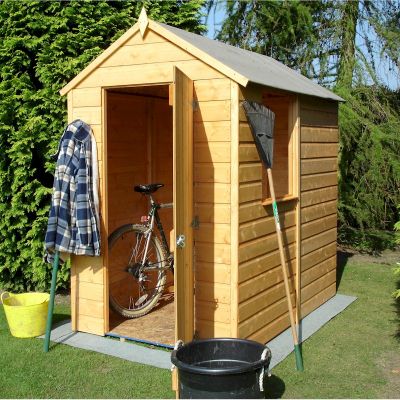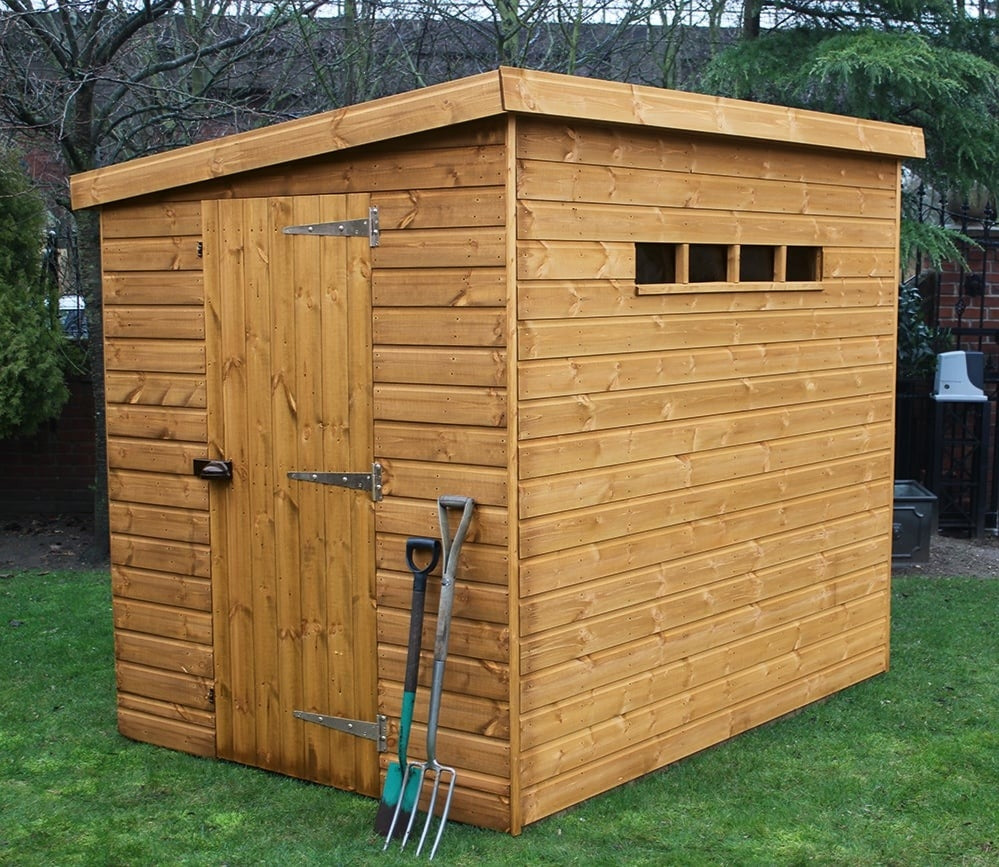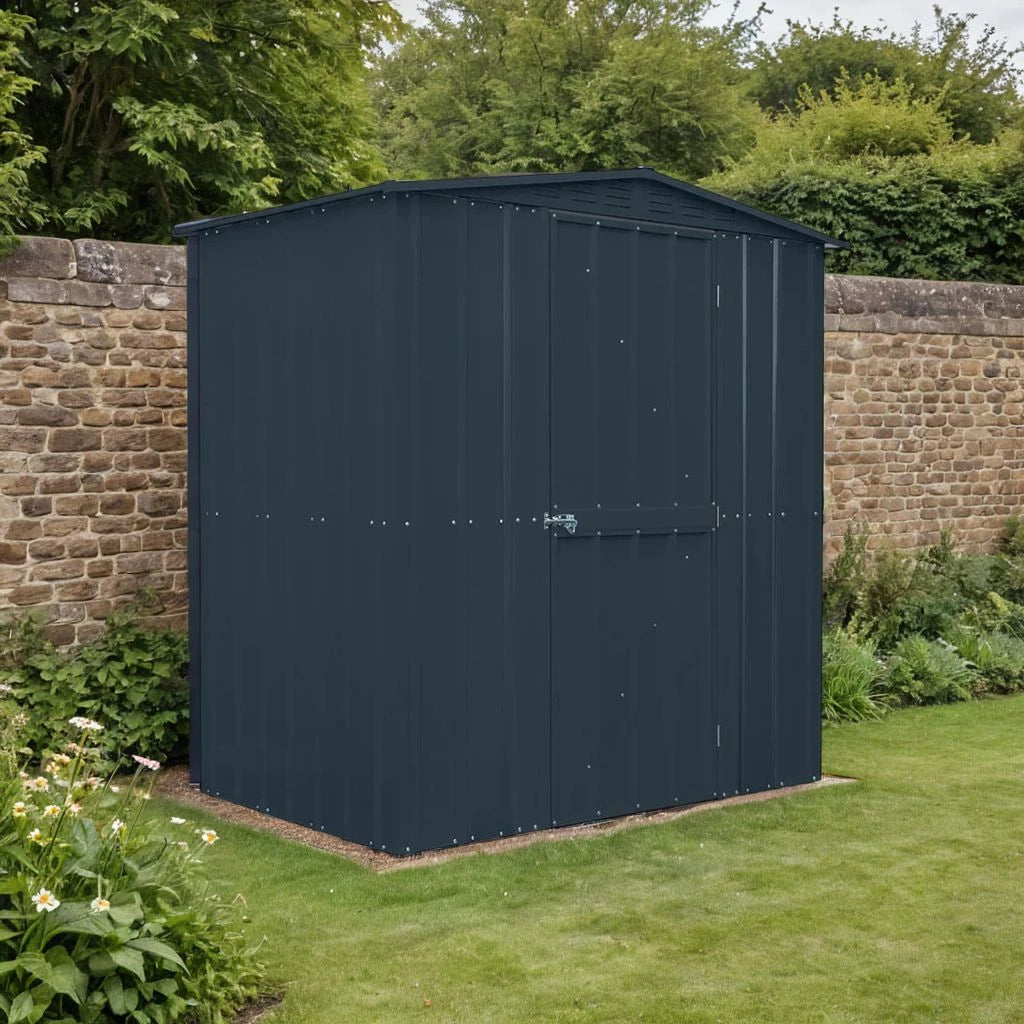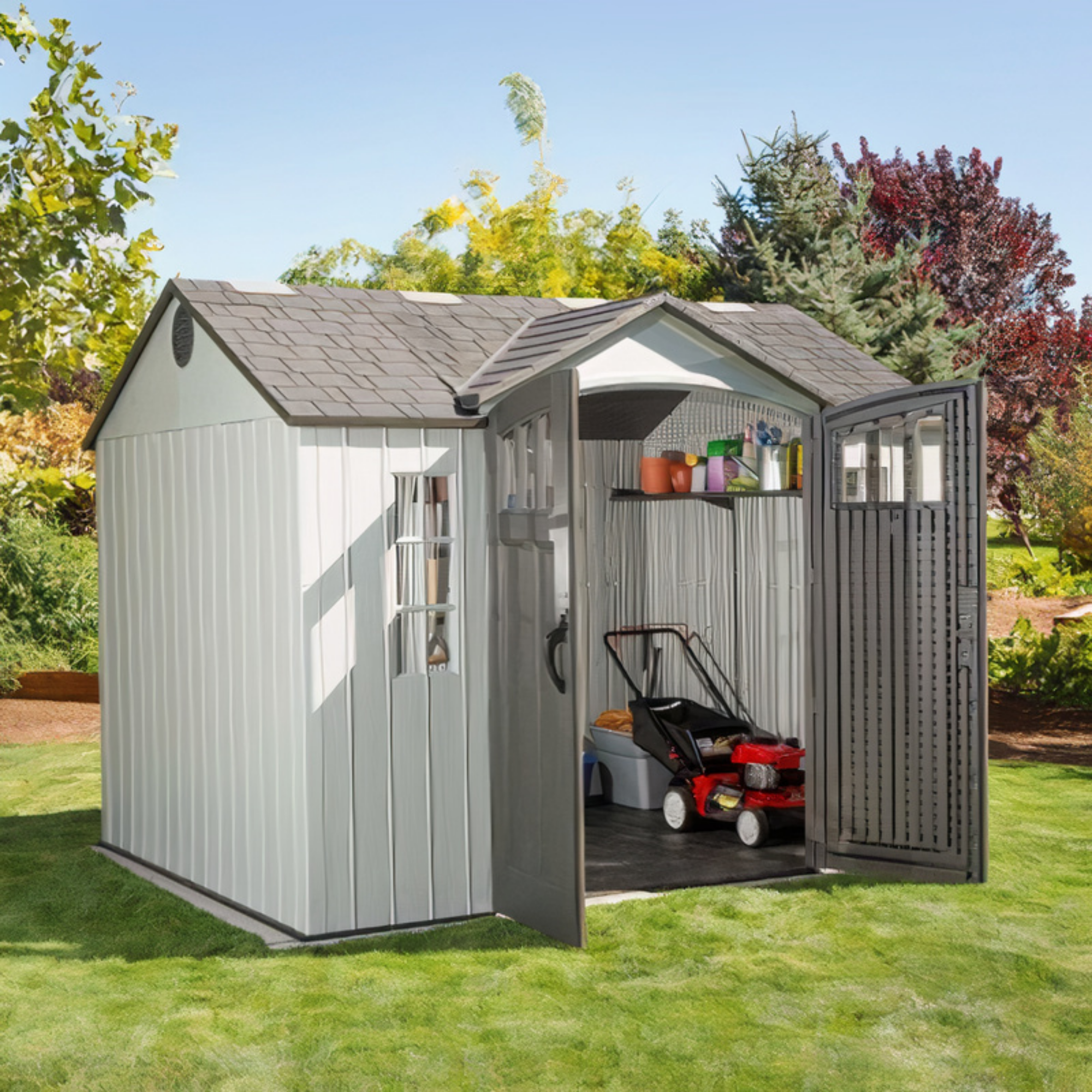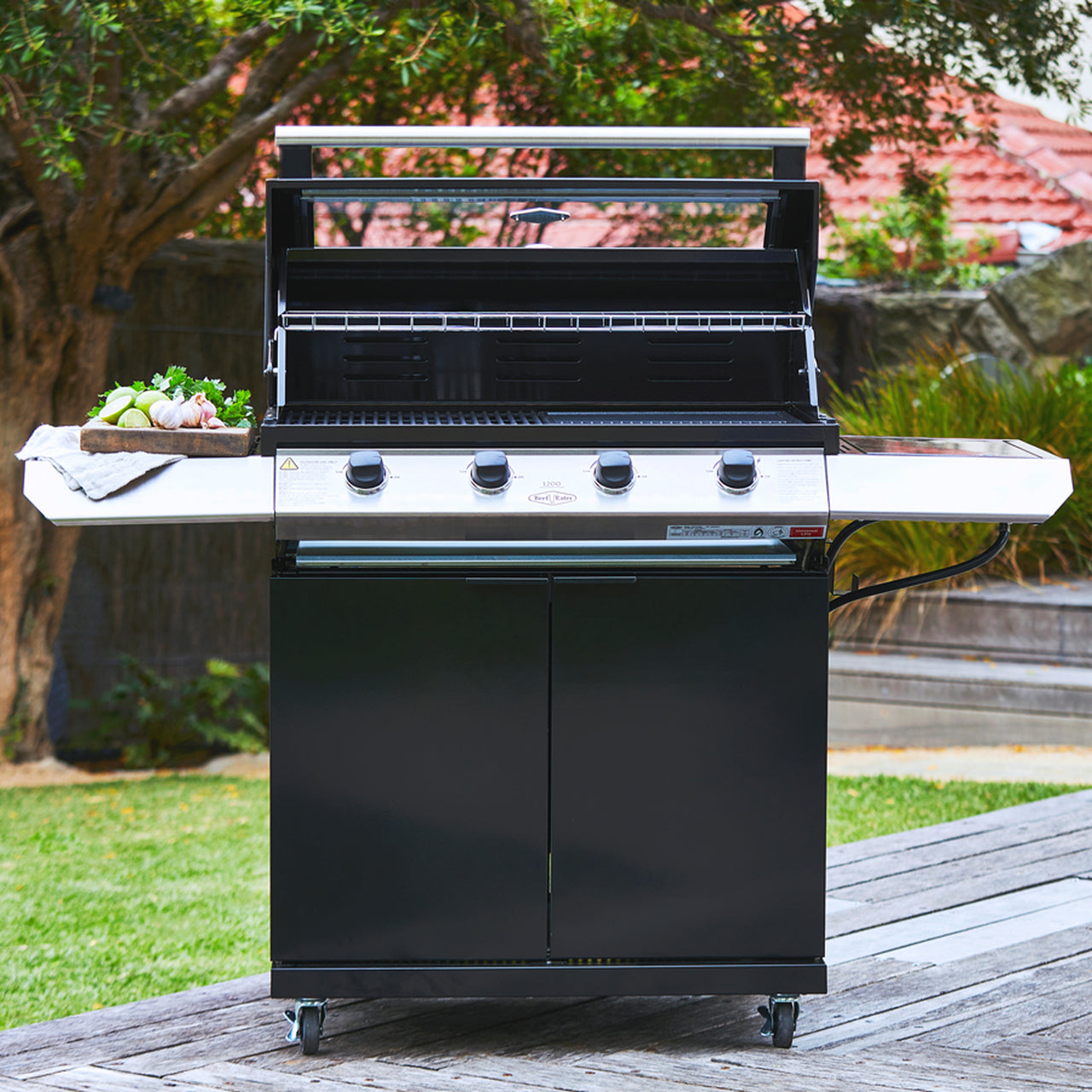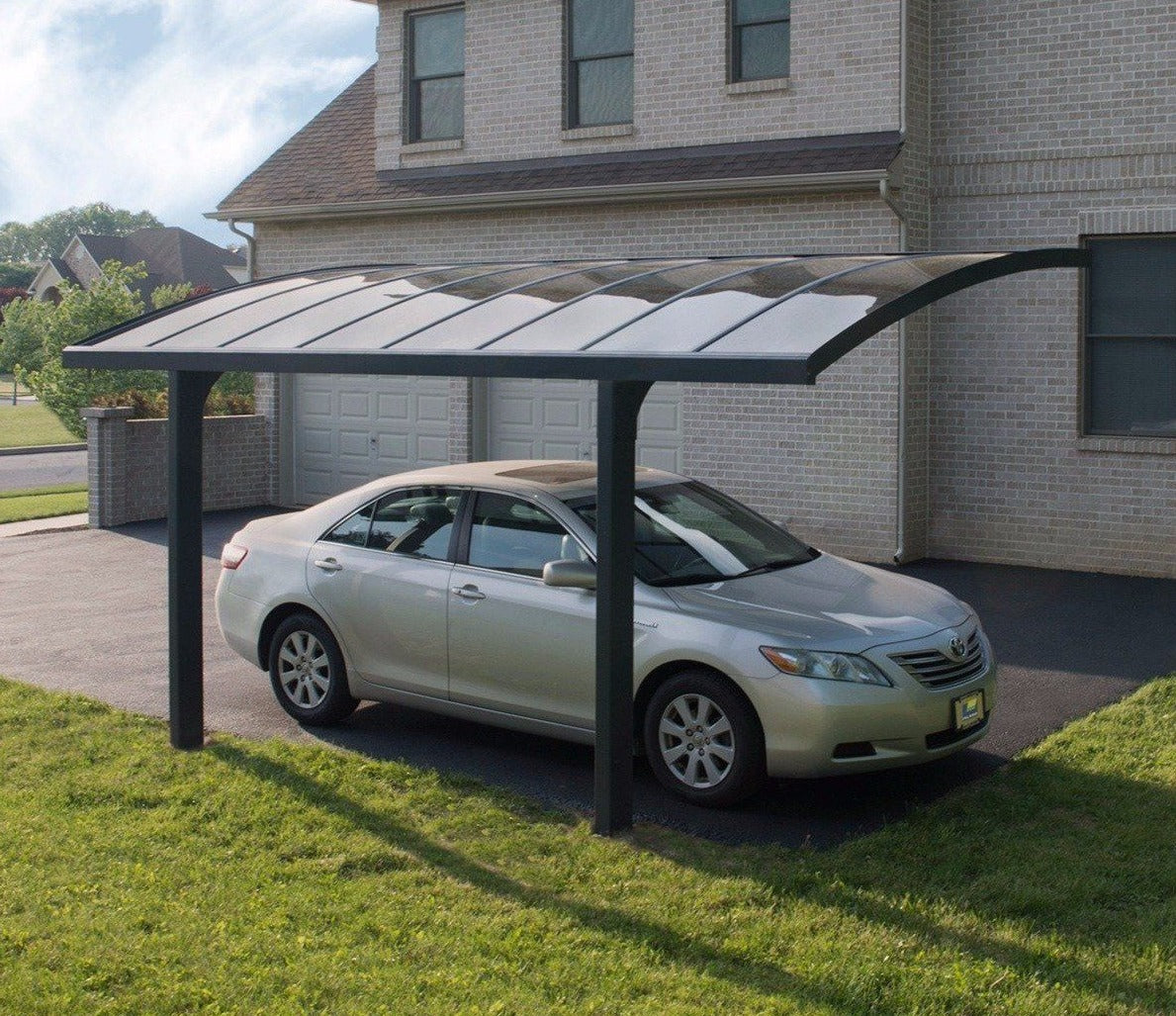The Ultimate Plastic Garden Shed Buyer's Guide: How to Choose the Best Shed for Your Needs

You know the scenario. Your lawnmower's taking up half the garage, there's a stack of plant pots cluttering the patio, garden tools are scattered between the utility room and the back door, and those outdoor cushions you bought last summer are somehow occupying your spare bedroom. Sound familiar?
Choosing a garden shed might seem straightforward at first, one of those things you'll sort out "at some point." But when you actually start looking, the questions pile up quickly. What size do you need? Should you go for plastic, wood shed, or metal? Which style suits your garden? And honestly, will it look ridiculous sat in the corner of your lawn?
Here's the thing, plastic garden sheds have become genuinely popular in the UK over the last few years, and for good reasons. They're weather-resistant without needing constant treatment, they don't rot or rust, and surprisingly, they look much better than you might think.
The days of flimsy looking plastic structures are long gone. Modern plastic sheds are stylish, durable, and actually enhance your garden rather than detracting from it.
But with options ranging from compact tool sheds perfect for urban gardens to spacious garden buildings that could double as workshops, knowing which one suits your specific needs can feel overwhelming. That's where this buying guide comes in.
I'm going to walk you through everything you need to know when buying a shed. We'll compare plastic to wooden and metal alternatives, work out what shed size you actually need for your garden and what you're storing, look at the features that genuinely matter, discuss preparing the ground properly with a shed base, and I'll recommend specific products for different scenarios.
By the end, you'll know exactly what you're looking for, which will make your decision so much easier.
Why Choose a Plastic Shed Over Wood or Metal?
Right, let's start with the fundamental question. Why plastic?
The main advantage of plastic sheds is that they're essentially maintenance free. Once they're up, they're up. You don't need to treat them, paint them, or worry about them deteriorating. In our British climate, where we get rain, damp, occasional scorching sunshine, and then more rain, that's a massive benefit.
Compare that to a wooden shed, which yes, looks beautiful when it's new. There's something classic about timber. But wooden sheds need regular treatment with wood preservative or paint to prevent rot, especially in our wet climate. You're looking at treating it every couple of years at minimum, and even then, you might find damp getting in through gaps or the base starting to deteriorate. It's ongoing work that honestly, most of us don't get round to doing as often as we should.
Metal sheds are durable and they'll certainly last, but they come with their own issues. Rust can be a problem, particularly around door frames and fixings. Condensation is another big one, if you store anything fabric or paper in a metal shed, you'll likely find it gets damp. And have you ever been near a metal shed during heavy rain? The noise is something else. Plus, they can get extremely hot in summer and freezing in winter.
Plastic garden sheds avoid all these problems. Modern plastic garden sheds are made from UV-resistant materials, often polycarbonate panels or high-quality PVC, which means they won't fade in sunlight or become brittle over time. The construction is designed to withstand British weather conditions without deteriorating.
They're also surprisingly strong. We're not talking about the type of plastic you'd find in a storage box. These are engineered materials designed specifically for outdoor use as a garden building. Virtually unbreakable polycarbonate, reinforced panels, rust-resistant frames, the construction quality has improved enormously.
From an environmental perspective, many plastic sheds are fully recyclable, which is worth considering if sustainability matters to you. And whilst we're addressing concerns, let's tackle the aesthetics question head-on. Plastic sheds don't look cheap or flimsy anymore. Available in colours like dark grey, tan, and dark tan, they blend into gardens beautifully. Some have Mediterranean-inspired designs, others have sleek modern lines. The quality of finish is genuinely impressive.
So when you're weighing up the different types of shed available, plastic offers brilliant long-term value. No ongoing maintenance costs, no weekend spent applying wood treatment, no rust spots to deal with. It's genuinely the most practical choice for most UK gardens.
The Different Plastic Shed Sizes and What They Mean for Your Garden
Before you fall in love with a particular shed, you need to work out what size will actually fit in your garden and, more importantly, what size you genuinely need.
Start by measuring your available space. And I mean actually measuring, not just eyeballing it. Get a tape measure out and note down the area you're thinking of using. Remember, you'll need to leave some space around the shed for access, particularly around the door. There's nothing worse than getting a shed delivered only to realise you can barely open the door because it's too close to the fence.
Shed sizes can be a bit confusing because they're often listed in feet (like 6x8 or 4x6), but the actual dimensions will be given in metric measurements. Generally, the first number is the width and the second is the depth, so a 6x8 shed is roughly 6 feet wide and 8 feet deep. Always check the exact measurements in centimetres or metres before ordering.
Planning permission is something to be aware of, though for most garden sheds you won't need it. Generally, you can put up a garden building without planning permission as long as it's not taking up more than half your garden, it's not higher than 2.5 metres, and it's not right on your boundary (or if it is, it's under 2.5 metres tall). If you're in a listed building or conservation area, different rules apply, so it's worth checking with your local council.
When determining what shed size you need, think practically about what you're storing. Are we talking a few hand tools and some pots? A lawnmower, strimmer, and garden furniture cushions? Multiple bikes for the family? A workspace for potting plants or DIY projects?
It's also worth considering your garden's proportions. A massive 8x10 shed might fit technically, but will it overwhelm a small garden and dominate the space? Sometimes a more modest storage shed that suits the scale of your garden is a better choice, even if it means being a bit more selective about what you store.
For smaller gardens, think about maximising vertical storage inside the shed. Hooks, shelves, and wall-mounted racks mean you can store more without needing a larger footprint.
One practical tip, if you're between sizes, it's usually better to go slightly larger. Gardens accumulate stuff. What seems like ample space now might feel cramped in a year's time when you've bought that pressure washer, those extra garden chairs, and three more bags of compost you couldn't resist at the garden centre.
Small Plastic Garden Sheds: Compact Storage Solutions (4x4 to 6x3)
If you've got a smaller garden, a compact patio, or you're working with limited space in an urban setting, a small plastic shed is perfect for keeping things tidy without taking over your outdoor area.
These sizes are ideal as a dedicated tool shed, somewhere to keep your spade, fork, secateurs, and hand tools organised in one place. They're also brilliant for garden equipment like a hover mower, extension leads, watering cans, and all those smaller items that somehow end up scattered around.

The Shire Tuscany EVO 120 4x4 Plastic Garden Shed with Double Doors is a genuinely lovely compact option. At 1225mm square, it fits into tight spaces whilst still offering proper storage. What I particularly like about this one is the Mediterranean-inspired design, it's got character without being fussy. The wide double doors are really practical, you can actually get things in and out easily, which matters more than you'd think when you're trying to manoeuvre a lawnmower or stack of plant pots.
It's made from durable, fully recyclable PVC and features three acrylic-glazed windows, so you get natural light inside. That might not seem important until you're hunting for something at the back on a grey afternoon. The weather-resistant construction means it'll handle everything our climate throws at it, and maintenance is minimal, just an occasional wipe down.

The SkyLight Plastic 6x3 Dark Grey Apex Garden Shed works brilliantly. At 183cm long but only 91cm wide, it fits along a fence line or in those awkward narrow spots in the garden. The dark grey colour looks modern and blends nicely with contemporary gardens. The apex roof design isn't just aesthetic, it provides better headroom inside and helps rain run off effectively.
This shed's made with UV-resistant materials that won't fade or become brittle in sunlight, which is important for longevity. It's perfect for storing garden tools, a few bikes if you prop them vertically, or seasonal decorations.

If you prefer a warmer colour that suits more traditional gardens, the SkyLight Plastic 6x3 Dark Tan Apex Garden Shed is the same practical design in a dark tan finish. The virtually unbreakable polycarbonate construction with a rust-resistant frame means this is genuinely built to last. It maintains a stylish aesthetic whilst providing ample space for your essentials.
For small gardens, these compact sheds solve the storage problem without overwhelming the space. They tuck into corners, sit neatly against fences, and keep everything organised without dominating your outdoor area.
Medium Plastic Sheds: Versatile Garden Storage (4x6 to 6x5)
Medium-sized plastic sheds are probably the most popular choice for average UK gardens. They offer that sweet spot between storage capacity and garden space, giving you room for multiple bikes, larger garden equipment like lawnmowers and strimmers, plus all your tools and seasonal items.
These sizes are ideal if you're an enthusiastic gardener who needs space for potting supplies, compost bags, and equipment. They're also brilliant for families where you're storing bikes for the kids, garden games, and outdoor furniture cushions over winter.

The SkyLight Plastic 4x6 Dark Tan Apex Garden Shed offers really practical proportions for British gardens. The slightly longer depth means you can store larger items without them sticking out awkwardly, whilst the width allows for proper organisation with shelving or hooks along the walls. The dark tan finish complements traditional brick houses and established gardens beautifully.
What makes this shed particularly versatile is the door width, you can get a wheelbarrow in and out, which might sound trivial but trust me, it's incredibly useful when you're dealing with garden waste or moving compost around.

For those who want a bit more space, the SkyLight Plastic 6x5 Dark Grey Apex Garden Shed is brilliant. The double doors provide excellent access, which really matters when you're moving larger items. The skylight roof panels are a fantastic feature, they allow soft natural light to illuminate the interior whilst maintaining privacy. You can actually see what you're doing inside without needing to prop the door open or install lighting.
Built-in ventilation slots are another thoughtful detail. They prevent moisture buildup, which protects your stored items from mould and mildew. This is particularly important if you're storing fabric items like cushions or canvas garden furniture covers. The weather-resistant construction handles heavy rain and snow without any issues, and honestly, it looks really smart in a modern garden with the dark grey finish.

The SkyLight Plastic 6x5 Tan Garden Shed offers the same excellent functionality in a classic tan colour that works beautifully in gardens with wooden fences or traditional planting schemes. It's the sort of shed that feels like it's always been part of the garden rather than a new addition.
Medium sheds like these are versatile enough to serve as proper garden storage whilst also being large enough for a small potting bench or workspace if you're into propagating plants or doing garden projects. They maximise storage without requiring a huge footprint in your garden.
Large Plastic Sheds: Spacious Garden Buildings (6x8 to 8x10)
If you've got a larger garden or substantial storage needs, a bigger plastic shed becomes more than just storage, it's a proper garden building that can serve multiple purposes.
These sizes are perfect for families with several bikes, extensive garden equipment, or those who want a dedicated workshop space for hobbies or DIY. You could set up a potting bench, store your lawnmower and tools, and still have room for garden furniture over winter. Some people even use them as outdoor gyms or hobby spaces.

The SkyLight Plastic 6x8 Tan Apex Garden Shed is properly spacious. Designed specifically for the British climate, this shed offers a secure home for garden tools, outdoor furniture, and seasonal decorations. The elegant tan finish and classic apex design mean it enhances rather than detracts from your garden aesthetic.
The UV-resistant materials ensure the colour stays true for years, and the apex roof provides excellent headroom. You can stand up comfortably inside, which makes a huge difference if you're actually working in there rather than just grabbing something and leaving.

For even more storage, the SkyLight Plastic 6x10 Dark Grey Apex Garden Shed is a serious piece of kit. At 10 feet deep, you've got room to properly organise everything. The dark grey colour looks fantastic in contemporary gardens and doesn't show dirt as easily as lighter shades.
This isn't just storage, it's a sanctuary for all your outdoor equipment. The blend into your outdoor space seamlessly whilst providing the capacity to store garden tools, outdoor furniture, bikes, sports equipment, and seasonal items all in one secure location.

If you prefer the warmer dark tan finish, the SkyLight Plastic 6x10 Dark Tan Apex Garden Shed offers identical functionality with that classic colour that suits traditional gardens brilliantly. The modern dark tan finish ensures your outdoor space remains tidy and clutter-free whilst looking smart.
Large plastic sheds like these are investments in how you use your garden. They're not just about storage, they're about creating organised, functional outdoor spaces where everything has its place.
Key Features to Look for in a Plastic Garden Shed
Now that we've covered sizes, let's talk about the features that actually matter when you're choosing a plastic shed.
Roof style is more important than you might think. Apex roofs, which peak in the middle like a traditional house roof, are brilliant for several reasons. They provide better headroom so you can stand upright comfortably, they allow rain to run off efficiently from both sides, and they generally offer more internal space. Pent roofs slope in one direction and work well if you're positioning the shed against a wall or fence, but apex roofs are usually more practical for freestanding sheds in garden settings.
Ventilation is absolutely crucial and often overlooked. Plastic sheds need proper airflow to prevent condensation building up inside. Look for sheds with built-in ventilation slots or vents. Without these, you'll find moisture accumulating, which can lead to mildew on stored items and that musty smell nobody wants in their garden storage.
Skylight or window features make a massive difference to usability. Natural light through skylight panels means you can see what you're doing inside without having the door propped open. It's one of those features you don't realise you need until you've used a shed with it, then you can't imagine going back to a dark interior.
Door configuration matters more than you'd expect. Double doors provide much better access than single doors, particularly if you're storing larger items like bikes, lawnmowers, or garden furniture. Think about what you'll be moving in and out regularly. Hinged doors are more common and generally more secure, whilst sliding doors can be space-efficient if you're tight on room to the side of the shed.
Floor inclusion varies between models. Some plastic sheds come with a floor, others don't. If there's no floor included, you'll need to provide a solid base, either a concrete slab or paving slabs work well. Sheds with floors included offer complete structural integrity and are generally easier to set up, though they may cost slightly more.
UV resistance is essential for any plastic garden building. Quality sheds use UV-resistant materials that won't fade, become brittle, or degrade in sunlight. This is particularly important in the UK where, despite what we say about the weather, we do get strong sunshine in summer months.
Lockable doors are important for security, especially if you're storing expensive garden equipment or bikes. Most decent plastic sheds will have some provision for adding a padlock, but check this before buying if security's a concern.
Anchor points and wind resistance features ensure your shed stays put during storms. The British weather can be unpredictable, and the last thing you want is your shed taking flight in a gale. Look for sheds designed to be anchored to the base properly.
Assembly considerations shouldn't be overlooked. Some sheds are easier to put together than others. Check reviews if possible to see what other customers say about the assembly process. Generally, the instructions should be clear, and the panels should fit together logically.
When a new shed comes with all these features, particularly things like built-in ventilation, skylights for natural light, and double doors, you're looking at a well-designed garden building rather than just basic storage.
Preparing Your Garden For A Shed: Shed Base Requirements
Here's something crucial that people often underestimate, your shed is only as good as what it's sitting on. A proper shed base absolutely matters for longevity, stability, and in many cases, for your warranty to be valid.
Why does the base matter so much? First, it provides a level, stable platform. Plastic sheds need to sit flat for the panels to align properly and the doors to open and close correctly. If your shed's on uneven ground, you'll have gaps between panels, doors that won't shut, and potential structural issues over time.
Second, a good base protects against moisture rising from the ground. Even though plastic doesn't rot like wood, having the shed sitting directly on soil or grass invites problems. Moisture can get inside, the ground underneath can become uneven, and you're more likely to get issues with insects or rodents.
Third, many manufacturers require a proper base as part of their warranty conditions. If something goes wrong and you haven't installed the shed on an appropriate base, you might find your warranty's invalid.
So what are your options for a solid shed base?
Concrete slabs are the gold standard. They're permanent, completely level, and provide excellent drainage around the edges. The downside is they're labour-intensive to install and expensive if you're getting professionals in. But if you're investing in a larger garden building and plan on it being permanent, a concrete base makes sense.
Paving slabs are a more accessible option for most people. Lay them on a bed of sand, ensure they're level using a spirit level, and you've got a solid base for your shed. This is probably the most common choice for UK gardens because it's effective and achievable as a DIY project. Just make sure the slabs extend slightly beyond the shed footprint for proper support.
Gravel bases work but require more preparation. You'll need to dig out the area, create a frame, lay membrane fabric, then add and compact the gravel. It's doable, but honestly, for the effort involved, paving slabs are usually easier.
Plastic shed base grids are a relatively new option that's become popular. They're plastic grid systems that lock together, sit on compacted ground or sand, and provide a level, stable base. They're good for drainage and quick to install, though you need to ensure the ground underneath is properly prepared and level.
Whatever base type you choose, ensuring it's level is absolutely critical. Use a spirit level, take your time, and get it right. A few hours spent on proper preparation will save you years of problems with an unstable shed.
Good drainage around your new shed is also important. You don't want water pooling around the base, so ensure rainwater can run off properly. A slight slope away from the shed or a gravel channel around the perimeter can help.
As for DIY vs professional installation, most people can prepare a shed base themselves if they're reasonably handy. There are plenty of online guides and videos. But if you're not confident or you're dealing with a large area that needs significant levelling, getting a professional might be worth it for peace of mind.
Maintenance and Longevity: What to Expect from Your Plastic Shed
Let's talk realistically about how long a plastic shed will last and what you'll need to do to keep it in good condition.
The good news is, plastic sheds are genuinely low-maintenance. We're not talking about the annual wood treatment ritual or rust management. Once your plastic shed is up, the ongoing upkeep is minimal.
You can expect a quality plastic shed to last 10 to 15 years easily, often longer if it's looked after. The UV-resistant materials mean they won't fade significantly or become brittle from sun exposure. The panels won't rot, rust, or corrode, which are the main killers of wooden and metal sheds respectively.
Maintenance requirements are straightforward. Give your plastic shed a clean once or twice a year with mild soap and warm water. A soft brush or sponge works fine for removing dirt, algae, or any general grime that accumulates. Avoid abrasive cleaners or harsh chemicals that might damage the UV protective coating.
Check the fixtures and fittings annually. Make sure screws and bolts are still tight, particularly after winter storms. This takes ten minutes and can prevent panels coming loose. If you notice any wear on door hinges or handles, these are usually easy to tighten or replace.
UV protection is built into quality plastic sheds, but over many years, you might notice some colour fading, particularly on dark colours exposed to constant direct sunlight. This is purely aesthetic and doesn't affect the structural integrity or weatherproofing of the shed.
Colour fastness varies between manufacturers, but generally, the better quality plastic storage sheds maintain their colour well. Dark grey might show more fading than tan over 10+ years, but we're talking subtle changes rather than dramatic differences.
Winter preparation for a plastic shed is minimal. Unlike wooden sheds that benefit from being cleared out and aired, or metal sheds where you need to check for condensation issues, plastic sheds just carry on. Clear any leaves or debris from the roof so water drains properly, and you're done.
Most plastic sheds come with warranties of around 5 to 10 years, which tells you what the manufacturer expects in terms of longevity. Read the warranty information carefully to understand what's covered. Usually, it's structural integrity and weatherproofing, but it won't cover damage from improper installation or extreme weather events.
Honestly, the maintenance requirements are part of why plastic sheds are so popular. You put them up, you use them, you give them an occasional clean, done. No ongoing costs for treatments or replacements, no weekend projects just to keep them functional. That's the appeal.
Colour and Style: Making Your Plastic Shed Look Good in Your Garden
Here's where plastic sheds have really improved over the years. They don't look like plastic anymore, if that makes sense. The styling and colour options available now mean you can genuinely choose something that enhances your garden rather than just tolerating it as functional storage.
The main colour options you'll see are tan, dark grey, and dark tan. Each works beautifully in different garden settings.
Dark grey plastic sheds suit modern, contemporary gardens brilliantly. If you've got sleek paving, minimalist planting, or a modern house, dark grey blends in perfectly. It's sophisticated without being stark, and it doesn't show dirt as easily as lighter colours. Dark grey works particularly well with slate grey fencing or rendered walls.
Tan or light tan finishes are classic and complement traditional British gardens beautifully. They work with wooden fences, brick houses, and established planting schemes. There's something warm and approachable about tan that feels right in cottage-style gardens or anywhere you want the shed to feel like it's always been there.
Dark tan sits between the two, offering warmth whilst being slightly more contemporary than standard tan. It's a versatile choice that works across different garden styles and tends to age well, developing character rather than looking tired.
Modern plastic garden buildings have genuinely evolved aesthetically. The panel designs often mimic wood grain or have subtle textures that catch the light nicely. Apex roofs give classic proportions that look intentional rather than utilitarian. Window and skylight features add visual interest and break up large expanses of plain colour.
If you want to add more character to your garden building, climbing plants work brilliantly. A clematis or climbing rose trained up a trellis attached to one side softens the structure and helps it blend into the garden. Just avoid anything too vigorous that might damage panels or interfere with roof drainage.
The key is choosing a colour that complements your existing garden rather than fighting against it. Stand in your garden, look at the house, the fencing, the predominant colours in your planting, then choose the shed colour that fits. It's worth taking the time to get this right because you'll be looking at it for the next decade or more.
Getting the Best Value: Understanding Plastic Shed Pricing
Let's talk about what you'll pay and what affects the cost, because understanding pricing helps you make a better decision.
Plastic shed pricing varies considerably based on several factors. Size is obviously the main one, a small 6x3 tool shed costs significantly less than an 8x10 garden building. You're paying for materials and the amount of plastic and framing required.
Features also affect cost. A basic shed with no windows or floor will be cheaper than one with skylight panels, double doors, built-in ventilation, and an included floor. Decide which features you genuinely need versus nice-to-haves based on your budget.
Brand and quality matter too. Established manufacturers using high-quality UV-resistant materials, with better warranties and proven longevity, charge more than budget alternatives. This is usually money well spent because the difference in lifespan and performance is real.
When comparing costs to wooden or metal sheds, consider the long-term picture. A wooden shed might seem cheaper initially, but factor in the cost of wood treatment every couple of years, replacement panels if sections rot, and your time maintaining it. Over 10 to 15 years, a plastic shed often works out more economical despite the higher upfront cost.
Metal sheds can be competitively priced, but again, consider ongoing costs if you need to treat rust, replace corroded fixings, or deal with condensation damage to stored items.
Shed offers do come up, particularly during quieter retail periods like January or September. If you're not in a rush, keeping an eye out for seasonal sales can save you a bit. But don't compromise on the shed for your needs just to save money, getting the wrong size or missing essential features is a false economy.
Understanding what's included in the cost matters. Does it come with a floor or is that extra? Are fixtures and fittings included? Is delivery free or charged? Sometimes what looks like a bargain becomes less appealing once you add the necessary extras.
If you're not confident with DIY, factor in professional assembly costs too. Some retailers offer this as an optional service. It adds to the overall cost but ensures the shed is installed correctly, which can be worth it for larger garden buildings.
Cost per square foot is a useful way to compare value between different sizes. Sometimes stepping up to the next size is surprisingly good value if the price per square foot works out similar or only slightly more.
The buying guide principle here is simple: invest in quality that suits your actual needs. A well-made plastic shed that's the right size and has the features you'll use is better value than a cheaper alternative that's too small or lacks essential features.
Assembly and Installation: What to Expect When Your Shed Arrives
Right, you've chosen your shed, it's been ordered, now what? Let's talk about delivery and assembly so you know what to expect.
Most plastic sheds are delivered flat-packed, with all the panels, framework, fixings, and fittings packaged together. Delivery times vary but typically you're looking at one to two weeks from order, sometimes quicker if the shed's in stock.
When your shed arrives, check everything's there before the delivery driver leaves. Count the panels against the parts list, check for any obvious damage during transit, and make sure all the bags of fixtures are included. It's much easier to sort out missing items immediately than discovering a problem halfway through assembly.
You'll need some basic tools for assembly. A screwdriver (power drill with appropriate bits makes life easier), a rubber mallet for tapping panels into place, a spirit level, and a ladder for reaching the roof sections. Some sheds require specific tools, so check the instructions beforehand.
Assembly is definitely a two-person job minimum. Some of the panels are awkward to hold in place whilst fixing, and you'll need someone to help with the roof sections. Don't attempt it alone, you'll just get frustrated.
Time investment varies by size. A small 6x3 shed might take 4 to 5 hours for two reasonably handy people. A medium 6x5 could take 6 to 7 hours. Large garden buildings like an 8x10 can easily take a full day, sometimes longer if you're taking your time or it's your first shed assembly.
Following the manufacturer's instructions carefully is crucial. I know it's tempting to glance at the diagrams and crack on, but plastic sheds have a specific assembly sequence. Getting panels in the wrong order or missing steps causes problems later. Read through the entire instruction booklet before you start, understand the sequence, then follow it methodically.
Common assembly tips: lay out all the parts and group them logically before starting. Don't fully tighten fixings until you're sure everything's aligned properly, you might need to adjust things. Check the shed's square and level regularly as you build. Use the spirit level frequently.
When it comes to anchoring the shed properly, this matters. Most plastic sheds have pre-drilled anchor points in the base frame. Use these to secure the shed to your base, whether that's concrete, paving slabs, or a plastic grid system. This prevents the shed moving in strong winds and ensures it stays stable.
If you're not confident about DIY or you simply don't have the time, professional assembly is available for most sheds. Yes, it costs extra, but it guarantees the shed's installed correctly, it's usually much quicker, and it's covered by some form of installation warranty. For larger or more complex garden buildings, this can be money well spent.
Once your new shed is assembled and anchored, give it a final check. Make sure doors open and close smoothly, all panels are secure, the roof's properly seated, and ventilation slots aren't blocked. Then start loading it up and enjoying your newly organised garden.
Common Questions When Buying a Plastic Shed: Quick Checklist
Before you make your final decision, here's a practical checklist to run through:
- Measure your available space accurately. Don't guess. Get exact measurements and remember to include access space around the shed, particularly in front of the door.
- Determine what you'll actually store. Be realistic. List everything: tools, bikes, lawnmower, garden furniture, sports equipment, seasonal items. This helps you choose the right shed size.
- Choose appropriate shed size with room to spare. If you're between two sizes and budget allows, go for the larger one. Gardens accumulate stuff, and having extra space is rarely regretted.
- Decide on essential features. Which features matter to you? Windows or skylights for natural light? Double doors for access? Built-in floor? Ventilation? Don't pay for features you won't use, but don't skip ones that'll make the shed genuinely more functional.
- Prepare or plan your shed base. Decide what type of base you'll use and either prepare it before the shed arrives or plan when you'll do it. The base must be ready before assembly.
- Check planning permission requirements. For most garden sheds you won't need it, but if you're in a conservation area, listed building, or building close to boundaries, check with your local authority.
- Consider access for delivery. Can the delivery vehicle reach your property? Will you need to carry panels through the house or down a side passage? Plan this beforehand.
- Budget for extras. Shelving, hooks, the shed base materials, possibly a padlock, maybe professional assembly. Factor these into your total budget so there are no surprises.
- Read warranty terms carefully. Understand what's covered, for how long, and what conditions apply. Keep your proof of purchase and warranty documentation.
- Plan assembly help. You'll need at least one other person, ideally two. Book them in advance and allow a full day for larger sheds.
Going through this checklist ensures you've thought about everything and helps avoid those "I wish I'd known that before" moments once the shed's already installed.
Choosing Your Perfect Plastic Garden Shed
We've covered a lot of ground here, from understanding why plastic sheds work so brilliantly in British gardens, through to choosing the right size and features for your specific needs.
The beauty of plastic garden sheds is their practicality. They handle our weather without complaint, they don't need ongoing maintenance, and they've evolved to look genuinely good in modern gardens. Whether you need a compact tool shed for a small patio or a spacious garden building for extensive storage, there's a plastic shed that fits.
The best shed for your needs depends on three main things: the space you have available, what you need to store, and your budget. Measure carefully, think honestly about your storage requirements, and choose quality within your budget. A well-chosen shed will serve you brilliantly for 10 to 15 years or more.
Remember the key points. Prepare a proper shed base, it genuinely matters for stability and longevity. Choose features that you'll actually use, natural light, ventilation, and double doors make a real difference to functionality. Pick a colour that complements your garden. And follow the assembly instructions carefully, or consider professional installation for larger models.
Plastic garden sheds offer brilliant long-term value with minimal maintenance. You're not committing to annual treatments or ongoing repairs. You're choosing storage that'll quietly do its job year after year whilst keeping your garden organised and clutter-free.
Take your time choosing, measure accurately, and pick the shed that genuinely suits your garden and lifestyle. Your future self, the one who's not tripping over garden tools or cramming bikes into the garage, will thank you for it.
If you need any individual advice, do not hesitate to contact one of our friendly team. You can browse and shop our plastic garden sheds here.








